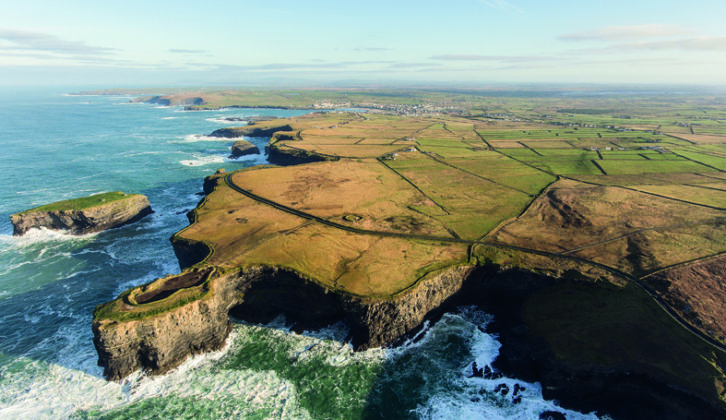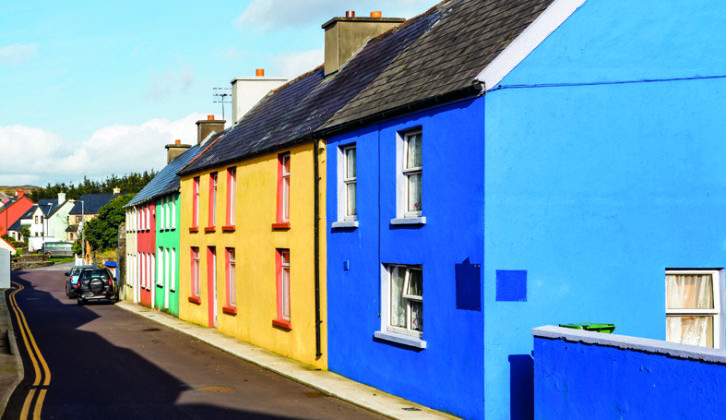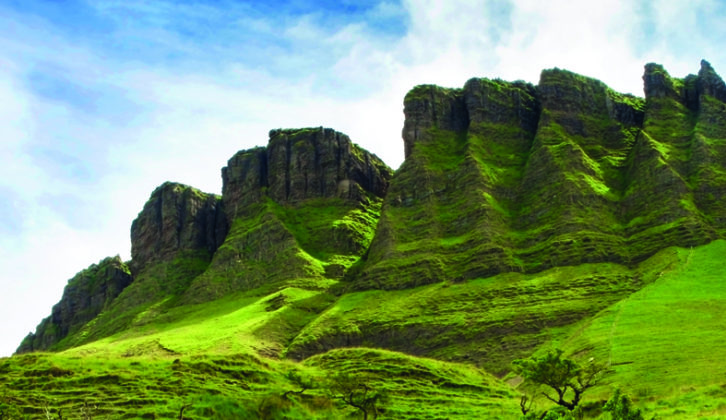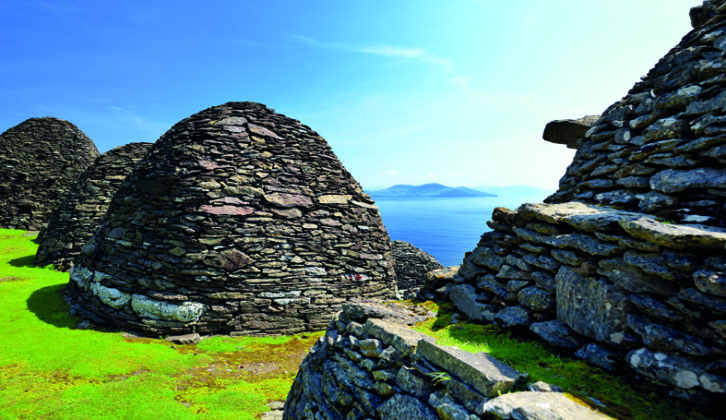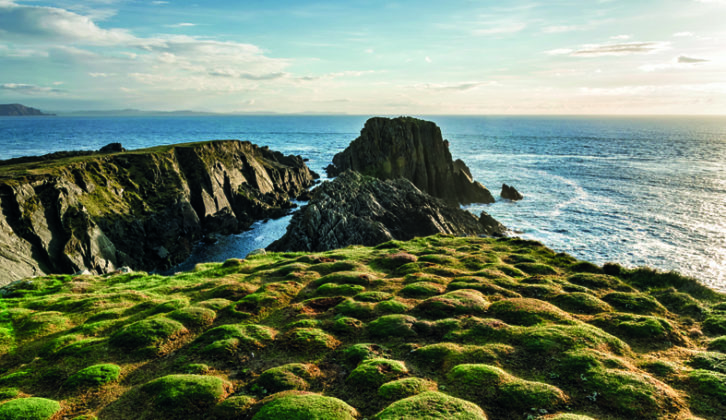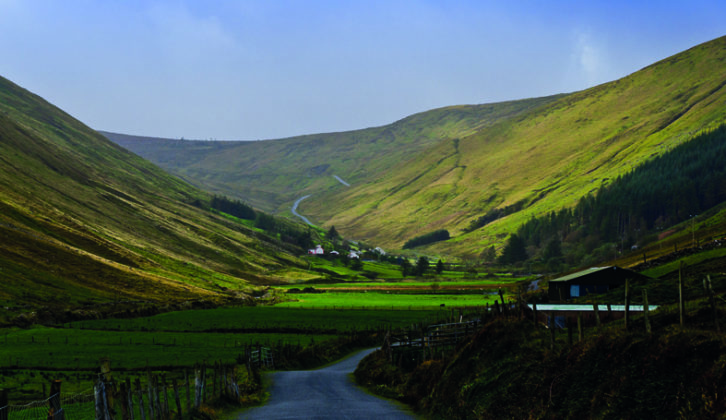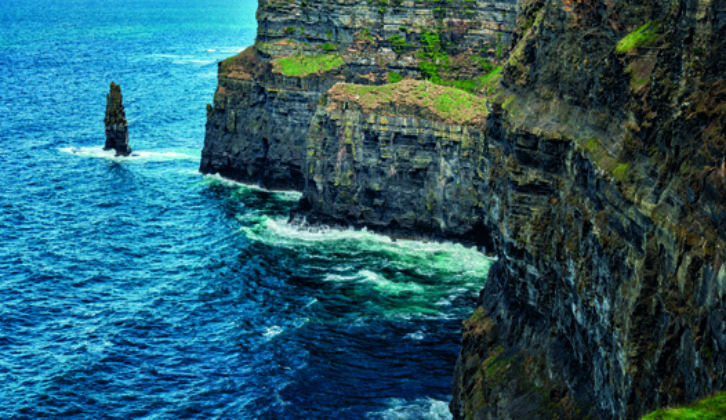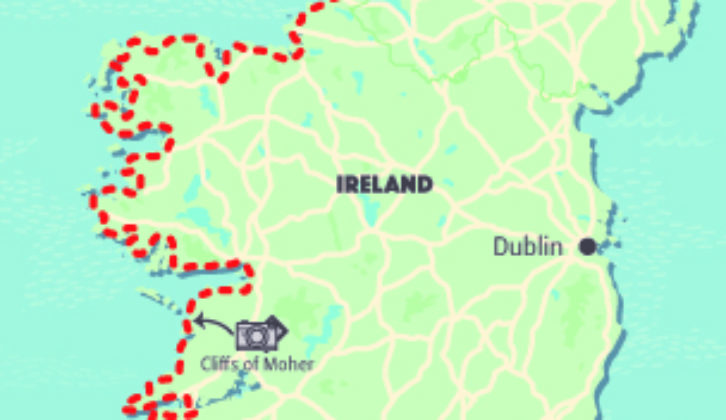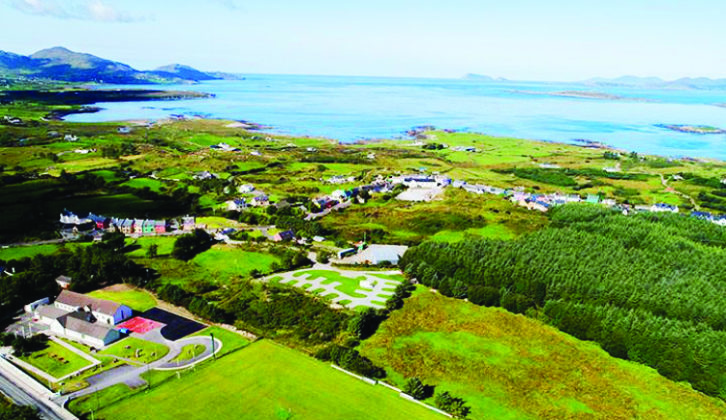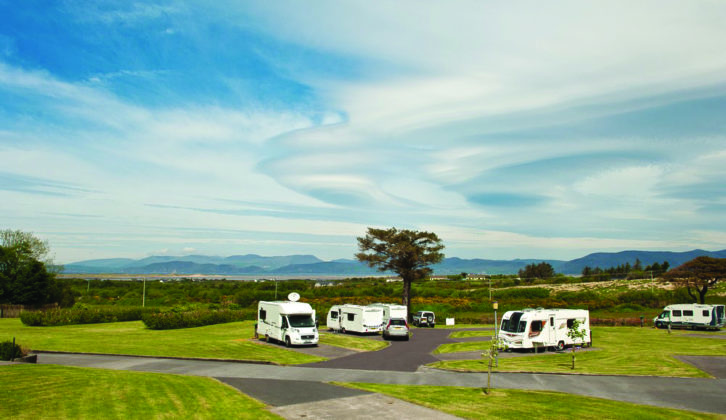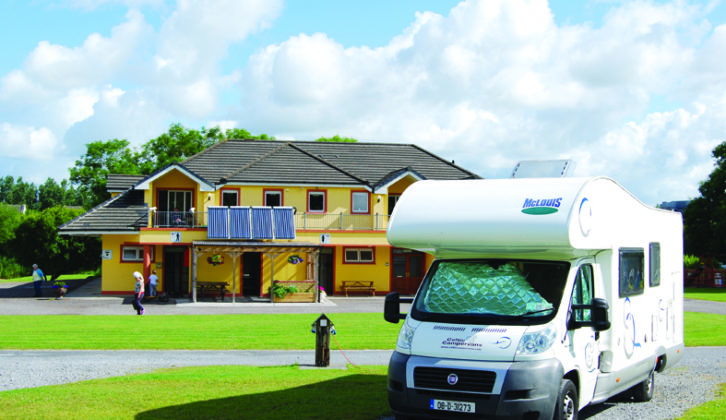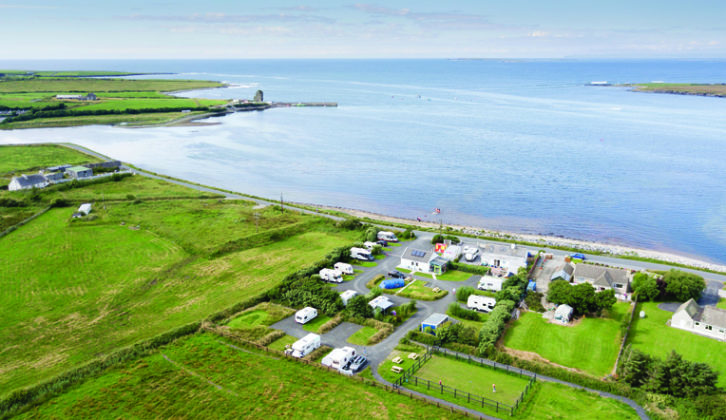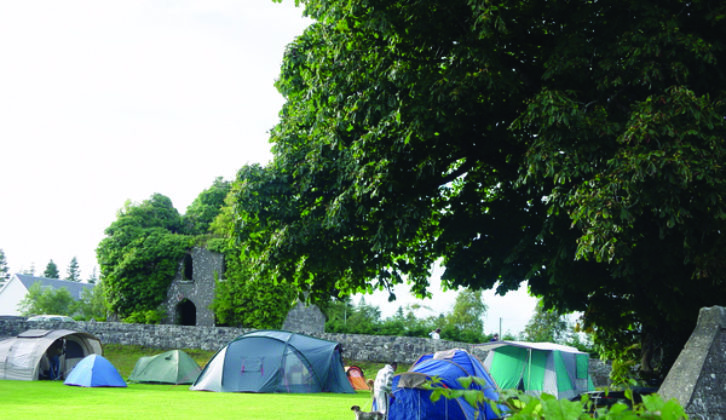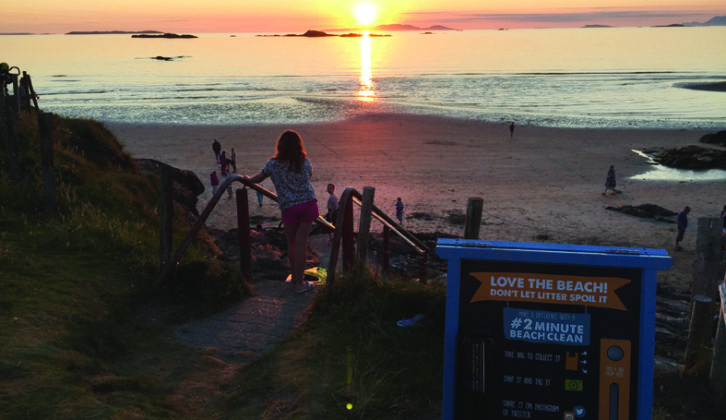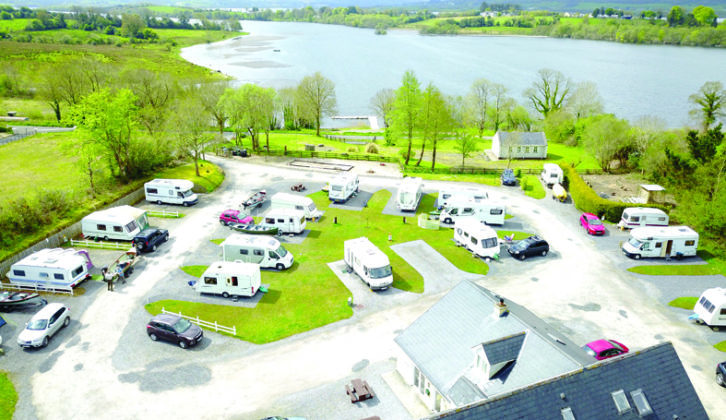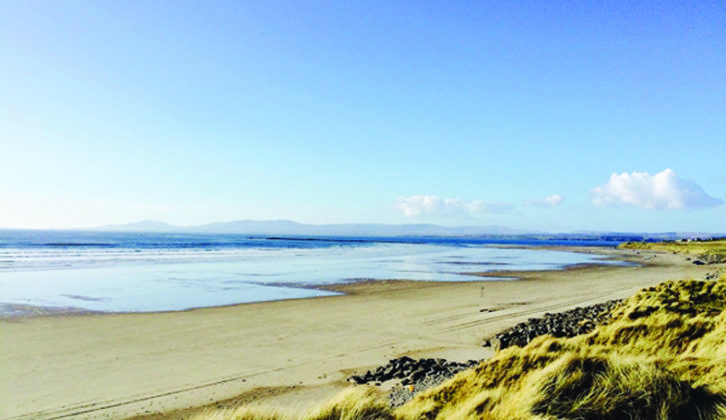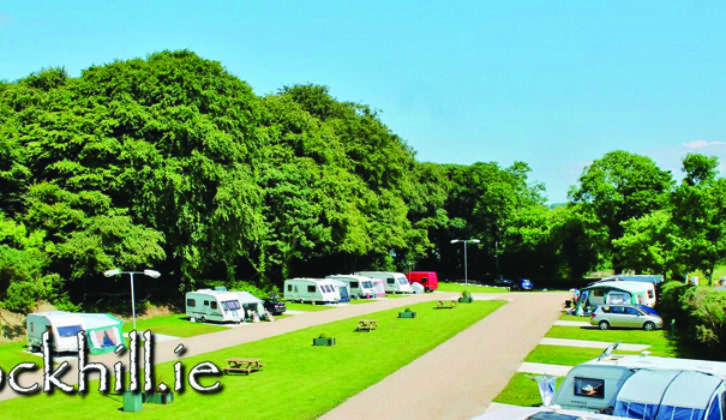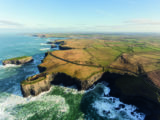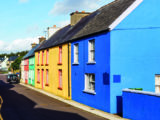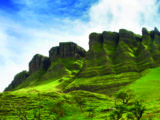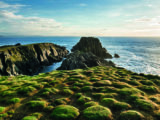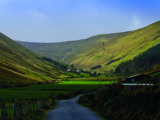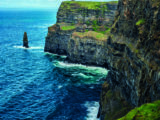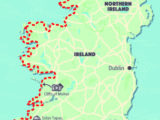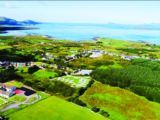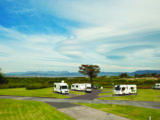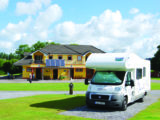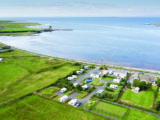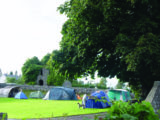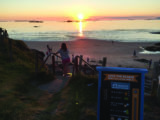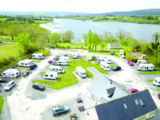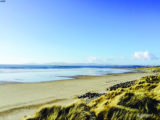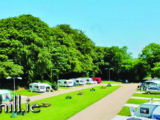If Jack Kerouac’s On The Road had been set in Ireland, the Wild Atlantic Way is the road they’d have taken. Weaving around the West coast, it clings to the outermost peninsulas, running the length of Ireland, from Kinsale in the south to Muff in the north, along sheer coastal and mountain roads.
Beyond the rolling Atlantic fog, around each bend lie wonders to behold – distant sea-worn hills falling away into the ocean, historic watchtowers and heart-stopping sunsets. The road tears past roaring village pubs and whale-filled bays, to the uppermost tip of Ireland, within sight of the Northern Lights.
Just south-west of Cork, in the chocolate-box town of Kinsale, is the starting point of the Wild Atlantic Way, a 2500km (1550-mile) journey to the Inishowen Peninsula in County Donegal. Following brown road signs adorned with a white wave – the very apt official symbol of the Wild Atlantic Way – travellers head north, meandering along the coastline, drinking in their first sights of the mighty Atlantic Ocean from the towering clifftops.
Beach and mountain
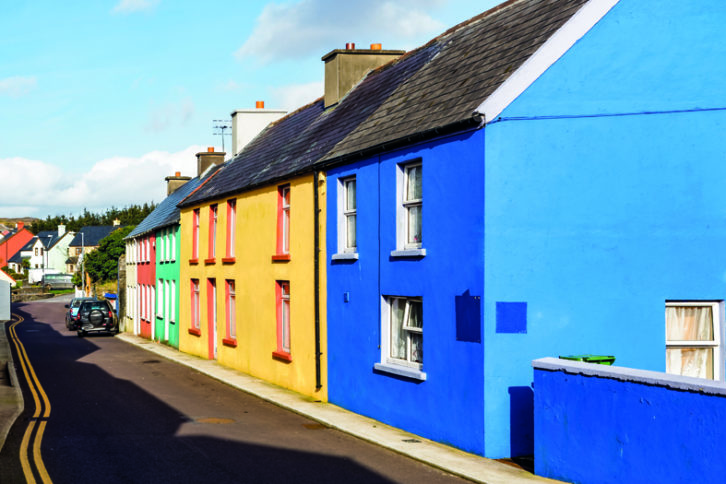
Passing Mizen Head, then Dursey Island, along sand beaches and peat hills, mountains begin to envelop the road as it rolls into Eyeries, a quintessential Irish village at the foot of the Slieve Miskish mountain range.
With a magical mountainscape and a horizon that bursts into mesmerising shades of orange and purple come sunset, this has been an artistic enclave for many decades. Here, even stout is an art form. For a drink with a view, visitors head to Causkey’s Bar, a no-frills drinking hole with one of the best pub panoramas in the whole of Ireland. Through its picture-frame windows, squat thatched cottages rest on windswept hills that roll into blue and white waves, with the rising swell of the Kerry Mountains in the foggy distance.
Afterwards, travellers take to the area’s many hiking trails. The Creha Quay Loop starts less than 50m from Causkey’s, for an easy walk with views stretching across the mouth of Kenmare Bay, to Scariff and Deenish Islands.
To warm the bones, restaurants dish up some of the finest seafood in Ireland, including lobster, mussels, hake and crab, caught by the locals. One fine example is Breen’s Lobster Bar, which offers modern interpretations on classic fish dishes.
The stellar Skellig Islands
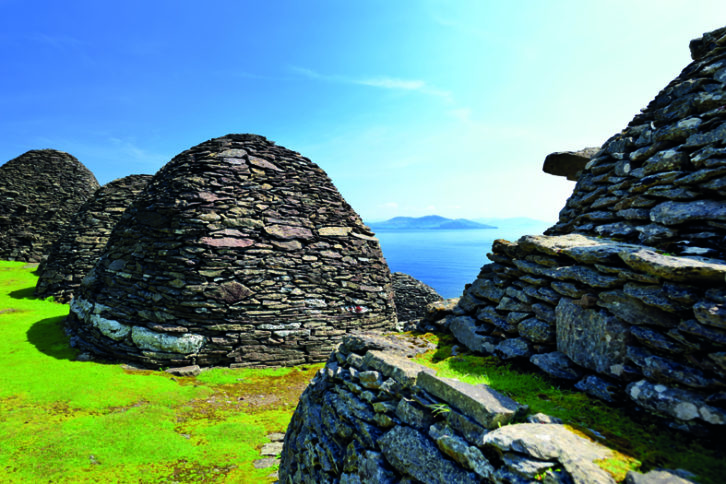
En route to Dingle, the remarkable Kerry Cliffs draw in passers-by with the promise of stellar views of the serrated Skellig Islands, rising 350m.
Around 400 million years old, the unmistakable islands rise from the ocean like twin pyramids.
Towering 218m above the Atlantic Ocean, Skellig Michael is a UNESCO World Heritage Site. Its summit is crowned by a well-preserved sixth-century monastic settlement, complete with beehive-shaped stone huts (cleverly designed to keep out the elements), and walled gardens for growing a variety of crops.
Fans of the Star Wars franchise will recognise Skellig Michael as Luke Skywalker’s hide-away in Episode VII: The Force Awakens and Episode VIII: The Last Jedi.
Boat tours focusing on the history and delicate ecosystem of the island run daily from the marina at Portmagee to Skellig Michael during high season, costing around £26 for children and £34 for adults.
Close by, on Little Skellig, some 30,000 pairs of northern gannets nest of this inhospitable isle each year, making this one of the largest gannet colonies in the world.
Peaks and valleys
Continuing north, you can zig-zag along the coast through Kenmare, a small town with a growing alternative live-music scene. But its main draw is the unmissable bay, where the ocean funnels into a lush green valley, crowned by mountain peaks. And on the northern shore of the bay, in Reenagross Park, an otherworldly rhododendron tunnel blooms in May and June.
Leaving Kenmare, the Wild Atlantic Way joins the ring of Kerry – one of the most famous scenic drives in Ireland. The cliffs here are taller, the water a deeper blue and the mountains positively sky-piercing. Lakes and loughs gleam across the landscape, and mysterious forts stand sentinel atop peat hillsides.
Adventurous souls stop at Inch Strand, a long, curved, sandy beach, for a spot of cold-water surfing. Alternatively, a quick dip in the ocean at a picturesque cove, near the dramatic ruins of the 16th-century Minard Castle, is guaranteed to enliven both body and mind.
Further to the west, the beautiful town of Dingle emerges, with cobbled streets and a vibrant social scene. Solas Tapas impresses with contemporary Irish interpretations of Spanish dishes, sourced almost exclusively from the Dingle Peninsula.
The journey continues west out of Dingle, along the cliffs of Slea Head Drive, passing Dunquin Harbour and on to Conor Pass, a narrow, twisting road through the mountains, only large enough for a small campervan in places.
At the highest point, a strategically placed car park gives drivers the chance to stretch their legs, take a deep breath of mountain air and feast on an iconic view. From here, the road leads to the ferry crossing in Tarbert, where you catch the Shannon Ferry, running every half-hour, to Killimer.
Cliffside walking
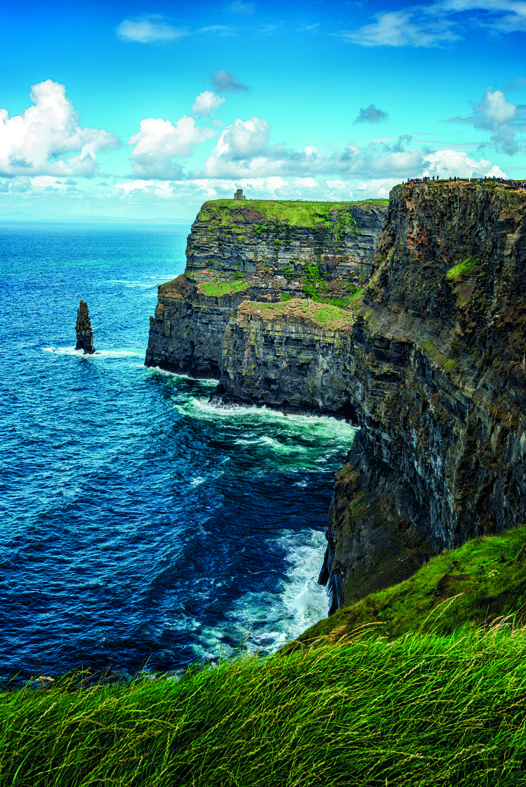
Beyond Killimer, the unmissable Cliffs of Moher loom on the horizon. More than 350 million years old, these shale and sandstone rocks stretch 8km along County Clare’s awe-inspiring coastline, rising 210m above the Atlantic Ocean.
With a hair-raising cliffside walking trail, the area is a haven for wildlife, home to razorbills, peregrine falcons and puffins.
After the cliffs, the traditional village of Doolin calls. Just 5km north, it makes an idyllic pitstop, with a handful of traditional pubs, complete with roaring woodfires, serving steaming bowls of Irish stew and creamy pints of porter.
This is also a handily located jumping-off point for adventurers with little time, keen to explore the ancient churches and prehistoric forts of the Aran Islands, just offshore.
Beyond Doolin, the karst (limestone) landscape of Burren National Park expands as far as the eye can see – eerie, desolate and otherworldly. And just a couple of kilometres off the Wild Atlantic Way, a 5,000-year-old megalithic burial tomb – Poulnabrone Dolmen – bursts up from the lunar landscape. Three gigantic vertical portal stones support an angled capstone, looking rather like a doorway to Ireland’s ancient past.
Thought to be Neolithic in origin, the tomb is believed to have been used well into the Bronze Age, and served as a Celtic ritual site.
After Galway, the Wild Atlantic Way cuts through wind-carved Connemara to Clifden, offering up magical panoramas of the ocean.
Passing through the coastal town of Westport, the road continues on its way north to reach the mesmerising sights of Sligo.
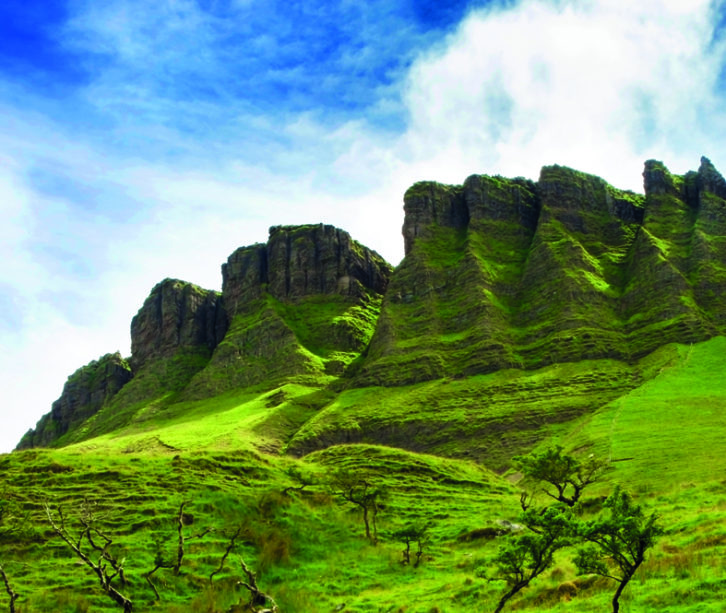
Here, 500m vertical walls of limestone jut out of the soft rolling hills at Benbulben, Ireland’s own Table Mountain. The giant formation, carved out by aeons of wind and rain, is the setting for many of Ireland’s great folktales, from the fianna, bands of conquering warriors to Tur na nÓg, the fabled land of eternal youth, and the tragic romance of Gráinne and Diarmuid.
Aurora borealis
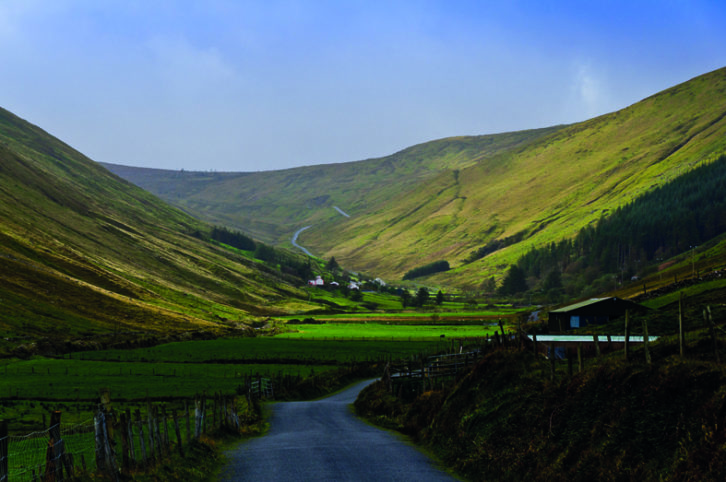
Heading into County Donegal, there’s no end to the jaw-dropping drives; but those in the know head to Glengesh Pass, which snakes down the bed of a wild emerald valley. Explorers seeking natural wonder stop at Malin Head, the most northerly point in Ireland, home to the Five Fingers Strand dunes, stunning sunsets and Nature’s lightshow – the aurora borealis.
On clear nights, visitors fill flasks with coffee, buy bags of steaming, vinegary chips, and stake out the Irish skies in search of the emerald streaks of the Northern Lights.
Alternatively, luxury private cottages, boasting huge windows perfect for scanning the skies, can be hired for around £200 a night.
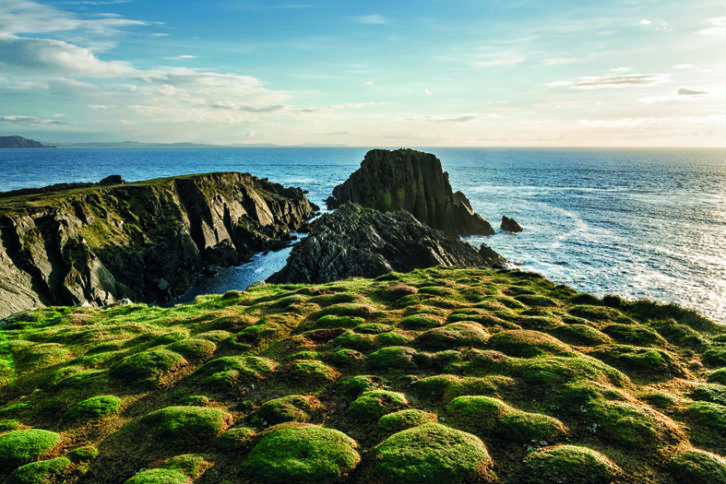
After Malin Head, the road rolls on to the village of Muff, on the border of Northern Ireland, and the end of the spectacular Wild Atlantic Way.
TOUR ESSENTIALS
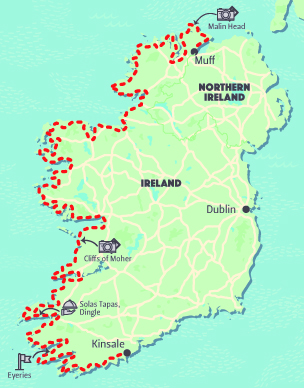
- How many days: At least 21
- When: Summer months
- Distance: 1550 miles
WHERE TO STAY
County Cork
Sextons Caravan and Camping Park
- R600 Timoleague to Clonakilty Road, Co Cork, P72 WY61
- Web sextonscamping.com
The Hideaway Camping & Caravan Park
- 10-14 Castletownshend Road, Carrigfadda, Skibbereen, Co Cork
- Web www.camping-ireland.ie/parks/cork/hideaway-camping-caravan-park
Barley Cove Holiday Park
- Crookhaven, Skibereen, Co Cork P81 X074
- Web barleycoveholidaypark.ie
Eagle Point Camping
- Ballylickey, Bantry, West Cork
- Web eaglepointcamping.com
Eyeries Motorhome Park
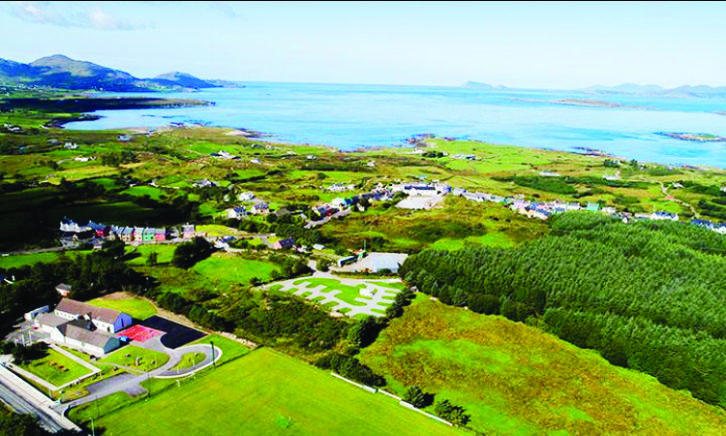
- Eyeries Villaeg, Breara, Co Cork
- Web https://eyeries-motor-home-park.business.site/
County Kerry
Killarney Flesk Caravan and Camping Park
- Flesk, Muckross Road, Killarney
- Web killarneyfleskcamping.com
Fossa Caravan & Camping Park
- Killarney Caravan & Camping, Fossa, Killarney, Co Kerry
- Web www.fossacampingkillarney.com
Fleming’s White Bridge Killarney Holiday Park
- White Bridge, Ballycasheen Road, Killarney, Co Kerry V93 HW56
- Web killarneycamping.com
Mannix Point Camping & Caravan Park
- Cahirciveen, Ring of Kerry Cost
- Web campinginkerry.com
Glenross Caravan and Camping Park
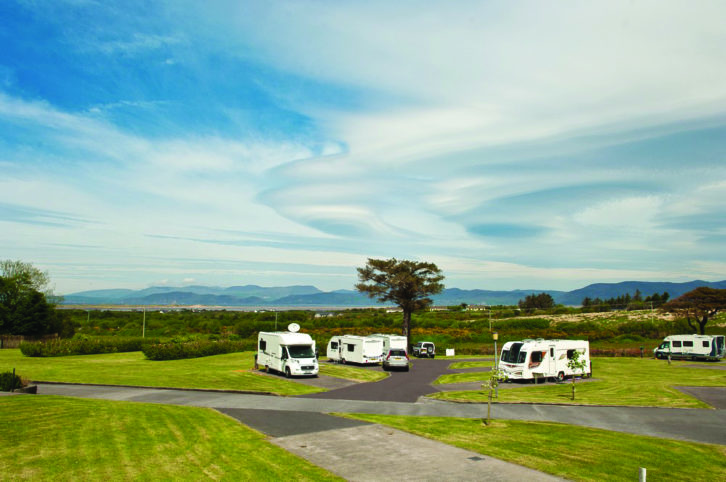
- Glenbeigh, County Kerry
- Web www.caravanclub.co.uk
Glenbeg Caravan and Camping Park
- Caherdaniel, Co Kerry
- Web glenbegcaravanpark.com
The Anchor Caravan Park
- Castlegregory, Co Kerry
- Web anchorcaravanpark.com
Woodlands Park
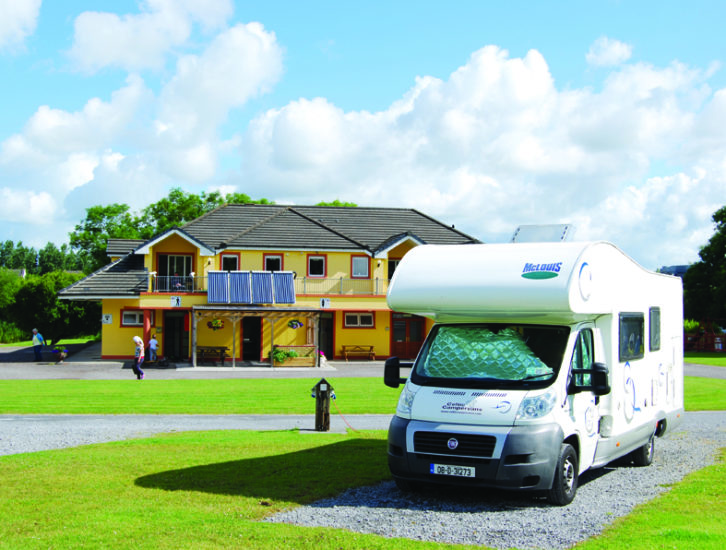
- Dan Spring Road, Tralee, Co Kerry, V92 RW89
- Web kingdomcamping.cm/caravans-motorhomes
Sandy Bay Caravan Park
- Castlegregory, Co Kerry
- Web www.sandybay.ie
County Clare
Greenacres Caravan & Camping Park
- Loop Head, Kilkww, Co Clare
- Web greenacrescamping.ie
Strand Camping Doonbeg
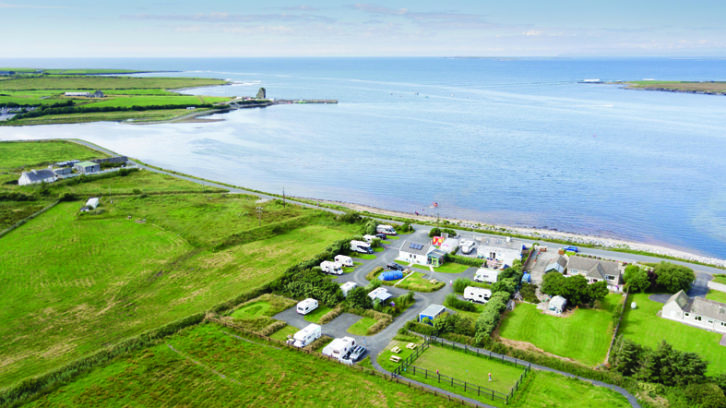
- Killard Road, Doonbeg, Co Clare, V15 W659
- Web strandcampingdoonbeg.com
Nagles Camping & Caravan Park
- Doolin, Co Clare
- Web www.doolincamping.com
County Limerick
Adare Camping & Caravanning Park
- Adare, Co Limerick, V94 E2C4
- Web www.adarecamping.com
County Mayo
Cong Camping, Caravan & Glamping Park
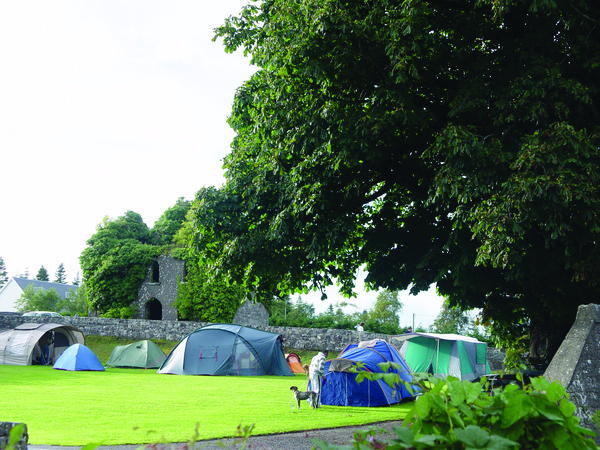
- Quay Road, Lisloughrey, Cong, Co Mayo, F31 XD56
- Web www.congcamping.com
Carrowkeel Caravan & Camping Park
- Ballyvary, Castlebar, Co Mayo, F23 NX74
- Web www.carrowkeekpark.ie
County Galway
Connemara Caravan & Camping Park
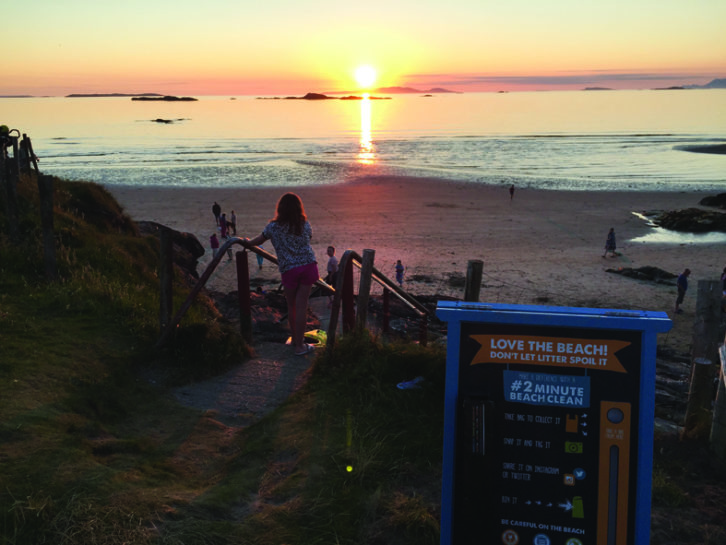
- Lettergesh, Gowlaun, Renvyle, Connemara, Co Galway
- Web connemaracamping.com
County Sligo
Strandhill Caravan & Camping Park
- Strandhill, Sligo, Co Sligo
- Web sligocaravanandcamping.ie/strandhill-park
Rosses Point Caravan & Camping Park
- Sligo, Co Sligo
- Web sligocaravanandcamping.ie/rosses-point-park
Lough Arrow Adults-Only Touring Park
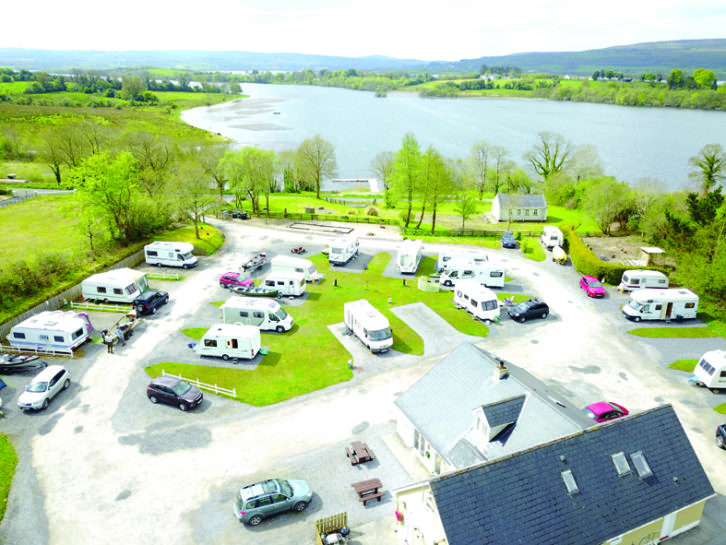
- Ballynary, Riverstown, Co Sligo, F52 K793
- Web lougharrowcaravanpark.com
County Donegal
Boortree Rossnowlagh Touring & Camping
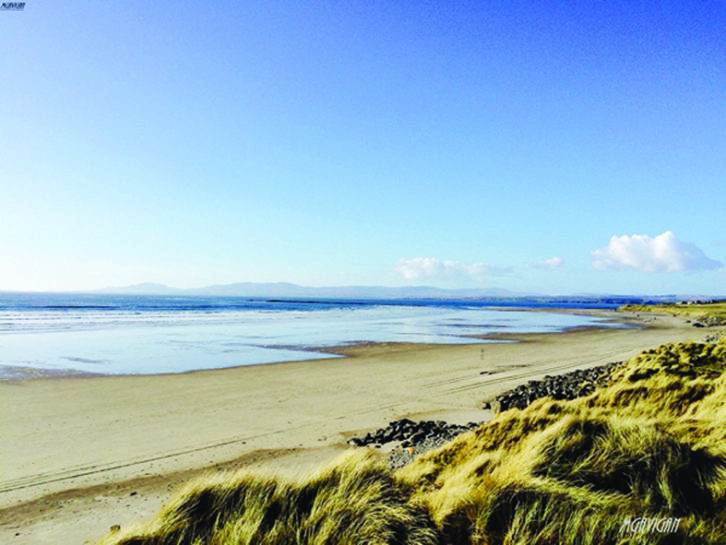
- Rossnowlagh, Co Donegal
- Web www.rossnowlaghcamping.com
Knockalla Caravan & Camping Park
- Magherawarden, Portsalon, F92 Y338
- Web www.knockallacaravanpark.com
Rosguill Holiday Park
- Melmore Road, Downings, Letterkenny, Co Donegal, F92 W965
- Web rosguillholidaypark.com
Wild Atlantic Camp
- Main Street, Creeslough, Co Donegal
- Web wildatlanticcamp.ie
Foyleside Caravan & Camping Park
- Quigley’s Point, Inishowen, Co Donegal
- Web foylesidecaravanpark.com
Rockhill Holiday Park
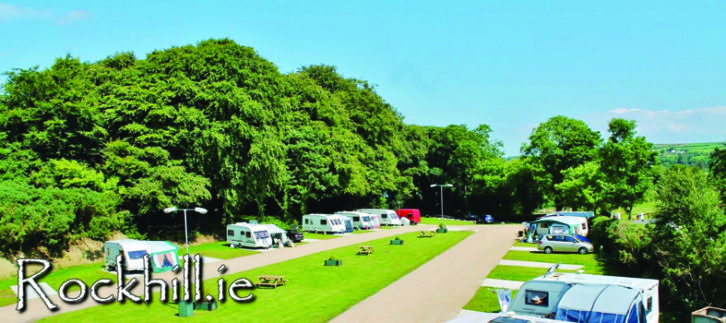
- Kerrykeel, Letterkenny, Donegal, F92 W0Y6
- Web www.rockhill.ie
TRAVEL TIPS
Driving The Wild Atlantic Way website offers plenty of handy hints and tips on driving the route.
Roads The quality of the road surfaces can vary from smooth Tarmac to rough gravel, so you should take your time. The route passes mainly through rural areas, so you can expect to encounter farm machinery, cattle, sheep and working dogs. The Wild Atlantic Way really can’t be rushed, so don’t expect to cover more than 65km per hour.
Petrol/diesel Fuel stations are few and far between in rural areas, so fill up at any opportunity to avoid running out of fuel. You should also be aware that some outlets don’t accept credit cards.
Navigation You might want to invest in a sat nav that gives the best routes for motorhomes, or check the next section of route on Google Maps before you start, to ensure it can be tackled by them.
Weather Pack a hooded mackintosh, stout shoes and layers. This coastal route can be windy; don’t bother with umbrellas!
If you liked this… READ THESE:
Ireland: Practical Motorhome Travel Guide
Northern Ireland: Practical Motorhome Travel Guide
Best van conversion under £50,000 for 2022
If you’ve enjoyed reading this article, why not get the latest news, reviews and features delivered direct to your door or inbox every month. Take advantage of our brilliant Practical Motorhome magazine SUBSCRIBERS’ OFFER and SIGN UP TO OUR NEWSLETTER for regular weekly updates on all things motorhome related.
Beyond Killimer, the unmissable Cliffs of Moher loom on the horizon. More than 350m years old, the shale and sandstone rocks strech 8km along County Clare's inspiring coastline
